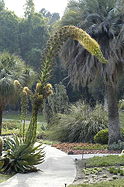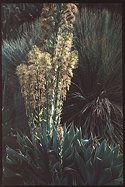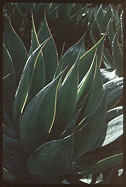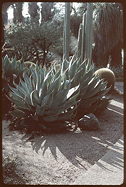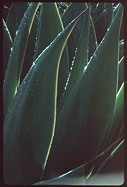Many succulents are referred to as “blue” by virtue of their glaucous waxy cuticle. This feature is typically enhanced with generous nutrition, which increases the proportion of new growth that bears this wax, or by cultivation under sheltered conditions, as in a greenhouse, where the wax is shielded from weathering by rain. While not as glaucous as some, and therefore not as “blue”, Agave ‘Blue Flame’ nevertheless evokes the image of a gas flame not only in the color of its new growth but also in the shape of the rosette with its gracefully incurved leaf tips.
We had considered naming this new cultivar Agave ‘David Verity’ in honor of its hybridizer but realized this might be confused with Aloe ‘David Verity’ (ISI 2001-20). Though not closely related, Aloe and Agave are alliteratively and horticulturally similar. Therefore, we embrace the name applied by Rancho Soledad Nursery where the plant has been tissue-cultured, making this introduction possible.
This hybrid is the first recorded between the two subgenera of Agave. A. shawii (subgenus Agave) the seed parent, imparts a measure of frost hardiness (to the low 20s °F) while A. attenuata (subgenus Littaea) lends its elegant, smooth foliage and graceful inflorescence. The foliage of the hybrid is flexible and nearly spineless like that of A. attenuata but with finely serrate margins and the rigid terminal spines of A. shawii. The inflorescence is also intermediate between the spike of subgenus Littaea and the panicle of subgenus Agave. The resulting hybrid bears an arching, spike-like panicle with a few reduced, ascending, lateral branches at its base, an unusual and distinctive arrangement.
Flowering occurs in fall and winter. The first recorded at the Huntington was Dec 1983, 16 years after it was received. Dave Verity made the cross during the early 1960s, when he was at UCLA’s Mildred E. Mathias Botanical Garden. Dave is long retired but still a recognized authority in southern California horticulture. We are pleased to publish yet another of his contributions to the Mediterranean gardening palette. Tissue-cultured plants of HBG 19706, $15.
Brian Kemble notes that my assertion is somewhat exaggerated that this is the first recorded hybrid between subgenera Agave and Littaea. Of course, I failed to recall the long-cultivated natural hybrid of A. victoria-reginae (Littaea) and A. scabra (Agave), the so-called “shark-skin agave”. Further, he notes that if one accepts the inclusion of Manfreda in Agave (based on fairly convincing molecular evidence though not yet widely adopted by collectors), there are three subgenera of Agave, not just two. Hybrids between subgenera Manfreda and Agave are also realized in Agave ‘Macho Mocha’, recently introduced by Yucca Do Nursery, among others, and apparently a hybrid between a manfreda and A. celsii (Littaea). We also grow an apparent hybrid of A. polianthiflora (Agave) and A. longiflora (Manfreda) that may merit future ISI introduction.

Published in the Cactus and Succulent Journal, Vol. 77 (2), March - April, 2005
